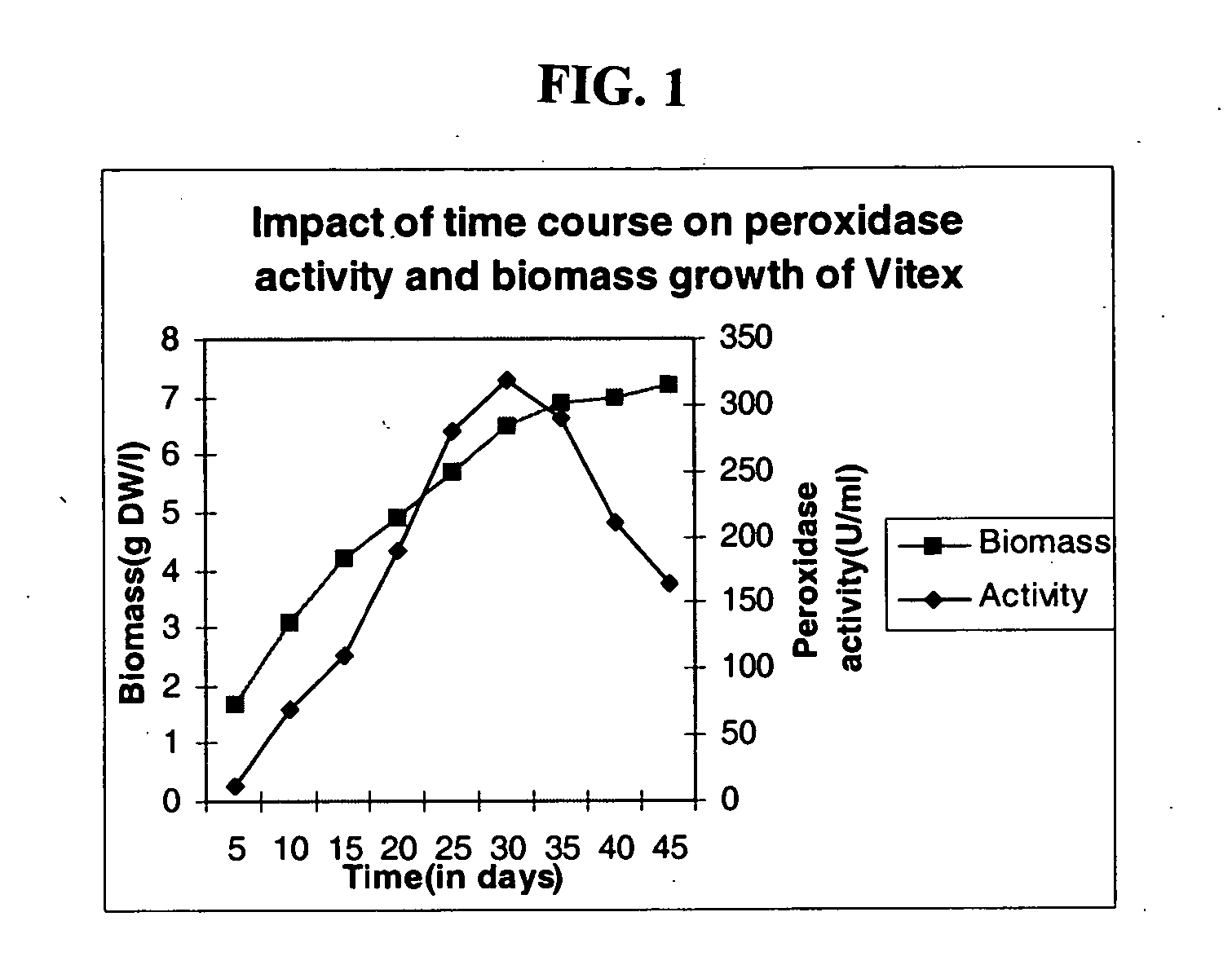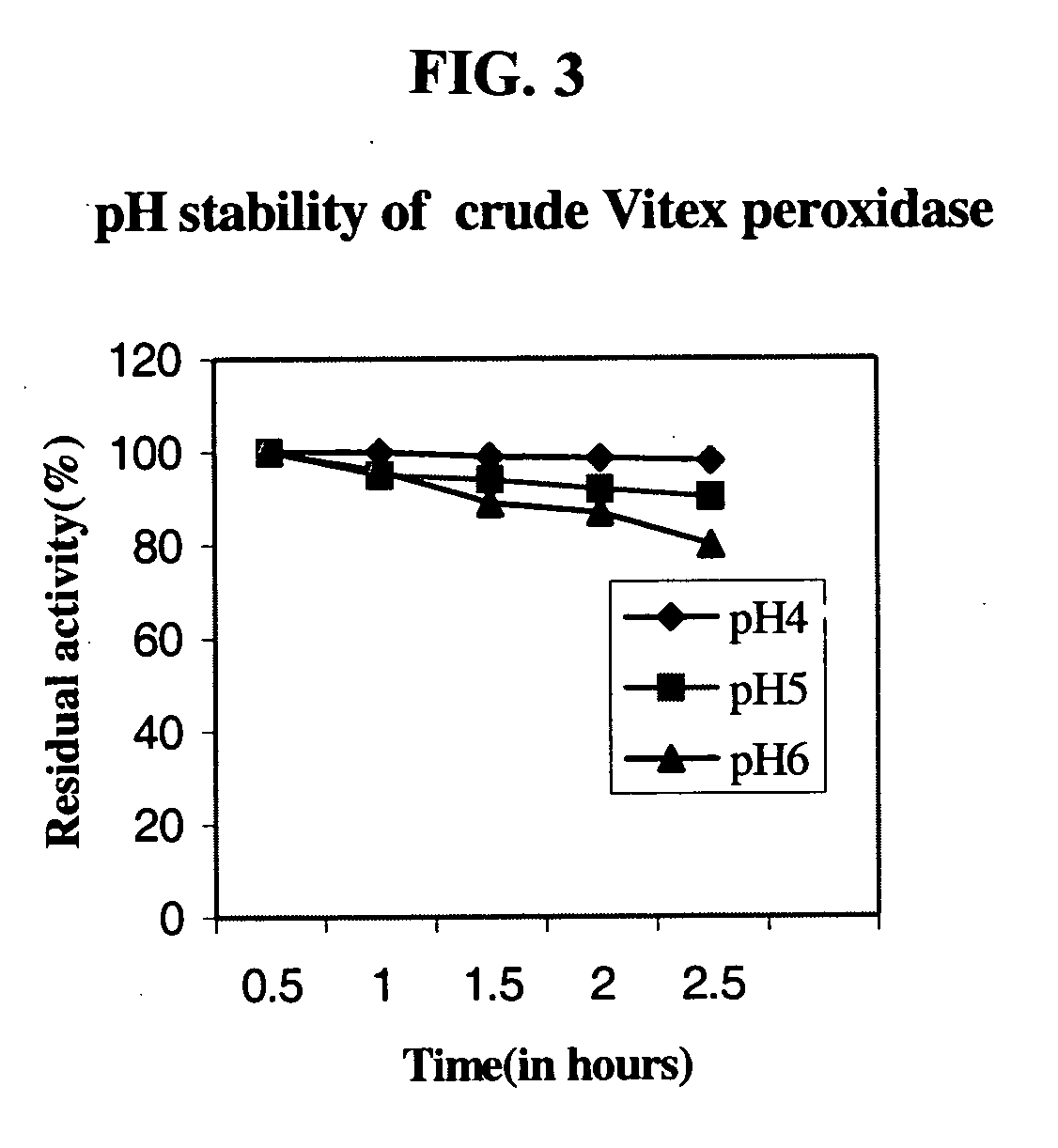Production of peroxidase from plant cell and callus cultures
a technology of peroxidase and callus, which is applied in the field of production process of peroxidase, can solve the problems of inability to achieve large-scale commercial production of callus, significant irreversible loss of enzyme activity, and inability to optimize the production of enzymes with growth regulators, etc., and achieves the effect of simplifying the recovery of enzyme activity
- Summary
- Abstract
- Description
- Claims
- Application Information
AI Technical Summary
Benefits of technology
Problems solved by technology
Method used
Image
Examples
example 1
[0119] Compact Callus Aggregates (CCAs) are established using leaf tissues of the plants, A.indica and V.negundo in full strength Murashige and Scoog (MS) medium augmented with auxins (2,4-dichlorophenoxyacetic acid, naphthalene acetic acid, indole-3-butyric acid) and cytokinins (6-furfuryl amino purine and benzyl amino purine) in different proportions under controlled conditions using sucrose as the carbon source. Suspension cultures of the said calluses are established and maintained using liquid Murashige and Skoog (MS) medium in Erlenmeyer flasks. The production culture can be carried out on a batch basis, or with semi-continuous or continuous culture techniques with periodic or continuous withdrawal of culture medium and / or cells for recovery of the product, i.e., peroxidase.
[0120] In all cases, pH was tried in the range of 5.6 to 6.0 and at a temperature of 23-27° C., albeit the optimum conditions for each species differ. Frequent enzyme assay shows optimum production of pero...
example 3
Production of Peroxidase Enzyme from Neem
1. Initiation and Maintenance of Callus Cultures
[0149]A.indica cultures were set up from leaf tissue. The leaf callus was initiated on B5 agar medium containing the hormones 2,4-dichlorophenoxyacetic acid (1 mg / L), and kinetin (0.1 mg / L), with 2% (w / v) sucrose as the carbon source. The pH was adjusted to 5.8 prior to sterilization. From this established suspension line, new cultures were set up by sterile transfer of 20 ml of 10 day culture into 100 ml of fresh medium in 250 ml Erlenmeyer flasks. The flasks are placed on a gyratory shaker at 150 rpm in the light at 25° C. The cultures referred to above were initiated in June 1994 (A.indica) and have been routinely sub-cultured since then. Throughout that time the cultures have remained viable and have showed substantially constant levels of peroxidase production.
2. Growth Parameters
[0150] Fresh and dry weight measurements for all the A.indica cultures were carried out according to the m...
example 4
Production of Peroxidase Enzyme from Nirgundi
1. Initiation and Maintenance of Callus Cultures of Nirgundi (Vitex negundo).
[0164] Leaf tissues were taken as explants for callus initiation after being properly washed in 10% Labolene followed by surface sterilization in 0.1% Mercuric chloride under aseptic conditions and inoculated in Murashige and Skoog (MS) medium containing 3% sucrose, 0.8% agar in addition to plant growth regulators like kinetin (6-furfuryl amino purine), BAP (benzyl amino purine), 2,4-D (2,4-dichlorophenoxyacetic acid), NAA (naphthalene acetic acid), IBA (indole-3-butyric acid) alone and in different combinations and sub culturing was also done in similar hormone combinations for proliferation. When no hormone was supplied in the medium, callus growth was very slow albeit showing good peroxidase activity. Auxins like IAA / NAA / 2,4-D was found to reduce both the callus growth as well as enzyme activity while a cytokinin like BA alone showed better callus growth as...
PUM
| Property | Measurement | Unit |
|---|---|---|
| Temperature | aaaaa | aaaaa |
| Temperature | aaaaa | aaaaa |
| Temperature | aaaaa | aaaaa |
Abstract
Description
Claims
Application Information
 Login to View More
Login to View More - R&D
- Intellectual Property
- Life Sciences
- Materials
- Tech Scout
- Unparalleled Data Quality
- Higher Quality Content
- 60% Fewer Hallucinations
Browse by: Latest US Patents, China's latest patents, Technical Efficacy Thesaurus, Application Domain, Technology Topic, Popular Technical Reports.
© 2025 PatSnap. All rights reserved.Legal|Privacy policy|Modern Slavery Act Transparency Statement|Sitemap|About US| Contact US: help@patsnap.com



